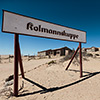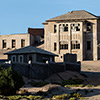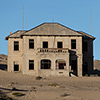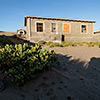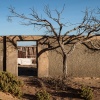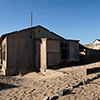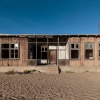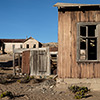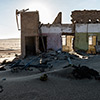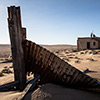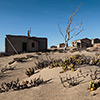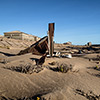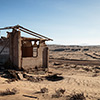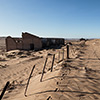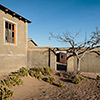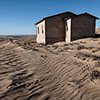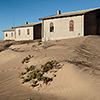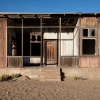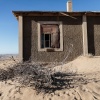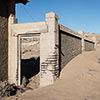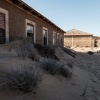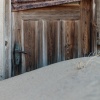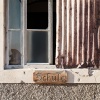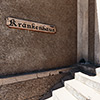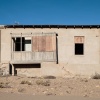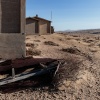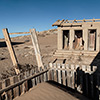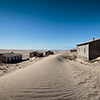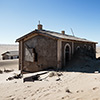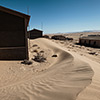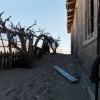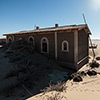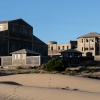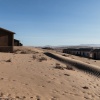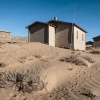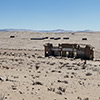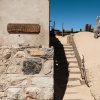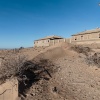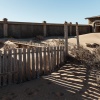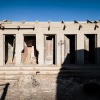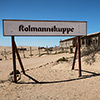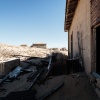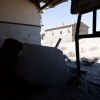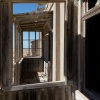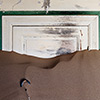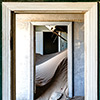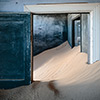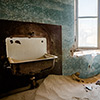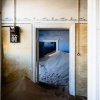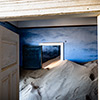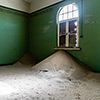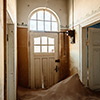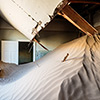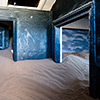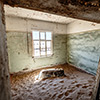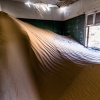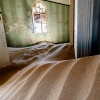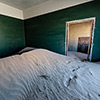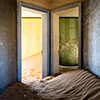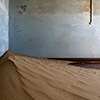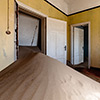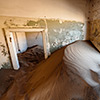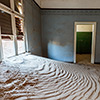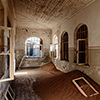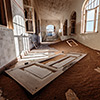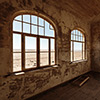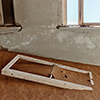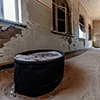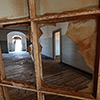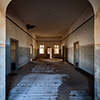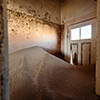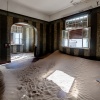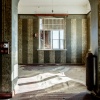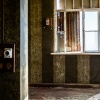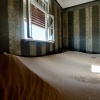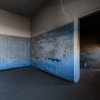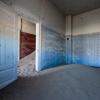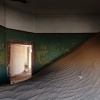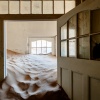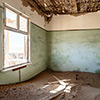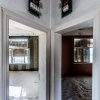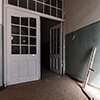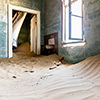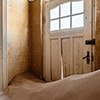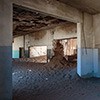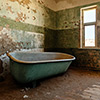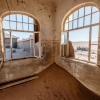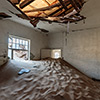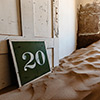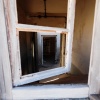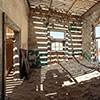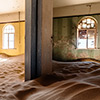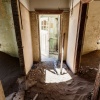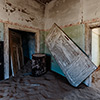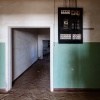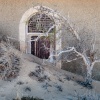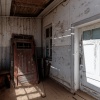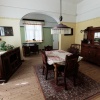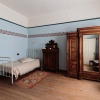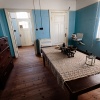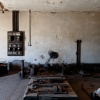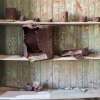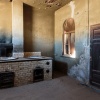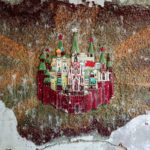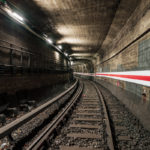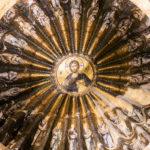Kolmanskop Ghost Town – Diamond Fever in the Namib Desert
Against the background of the imperial endeavours of Great Britain and France, Germany’s colonial adventures started late. One of those liaisons, that even today sparks a yern to see distant places, is German South-West Africa, nowadays Namibia, where at the turn of the century diamonds got found. The story of that boom tells Kolmanskop; the once richest settlement of Africa existed only to wring the gem stones from the desert but is now an abandoned ghost town being reconquered by the sand of the Namib
.
Rail Works into Happiness
Despite solitude and the dreary dominance of rocks and thousands of tons of sand, deserts are through and through magic places. Maybe it was that kind of magic inspiring soldier of fortune Adolf Lüderitz to take on the long way down to Namibia – in historical terms an extremely faraway place from his German hometown Bremen – to found the trading outpost of Lüderitz. During works on the TransNamib southern rail route to connect the town of Lüderitz with Seeheim, and make a link between Atlantic Ocean and Namibian inland, the desert unveiled an incredible treasure by human standards: diamonds.
The diamond deposits in the south of Namibia, being located in the triangle between Lüderitz, Aus and Oranjemund, are so rich, that the mining company can easily exist and profit until the 2050’s. The discovery the gemstones around the turn of the 19th century infected people with a diamond fever. Its silent witness, the abandoned diamond miners’ town of Kolmanskop, can be found shortly before Lüderitz. Nomen est omen, as the Afrikaans word Kolmanskop derives from the Nama Johnny Coleman, who got stuck in the desert with this oxcart at the same place where now the abandoned buildings get eaten by desert dunes.
Diamond deposits as well as the involving trade and sales vaulted the ~1300 German souls’ settlement of Kolmanskop onto Mount Olympus of wealth as this little hamlet, lo and behold, became Africa’s richest city within short time; some historians even claim Kolmanskop was the most prosperous town in the world at that time. They may have been right as before Word War 1st, within the first six years of mining, more than 1000kg of diamonds got produced, that is an equivalent of 5 million karat. Well, pomp and circumstance are entertaining but a fast moving and shallow companionship and when exploitation relocated southwards, further down to southern inland and closer to the coast line, the settlement got quickly left behind. The last moved out in 1956.
The town remnants peeping out of the Namib Desert like iceberg tips from Atlantic Ocean tell the story of those past days of gold diamond rush. The Namib sand, whipped by Herculean west winds, shows no mercy and invades every obstacle in its way making each indoor beach bar go green with envy. The desert regularly “swamps” the only road in that region, the B4, that has to be cleared by wheel loaders almost every day anew, but for the abandoned German miners’ houses next to the road from Seeheim to Lüderitz help comes too late.
Exploring the Ghost Town
It is early in the morning. The sun has just made it above the horizon. I park my car in the non-existing shade and start my photo trip. Entering the diamond exclusion area, Kolmanskop is part of that, is generally forbidden. To equalise that you need to get permission from Lüderitz-based office and if you want to walk around freely having a look at all buildings, or if you’re a professional photographer, then you even need an even more specific permit.
Same like Lüderitz the abandoned mine town is a proof of colonial Wilhelmine architecture as well, but of course with the difference that the Lüderitz settlement and its lovely houses at the Atlantic Ocean is kept in a much better shape. I wonder what Kolmanskop may have looked like some hundred years ago when the city was yet alive.
The former desert outpost of colonial Germany gets staged by a strong contrast between morning Austral sun and darkest shadows as well as the everything invading sand, rounded out by the scorching heat. Despite decline and decay many houses even today allow a conclusion what once happened and who lived here; for example the former school is clearly recognisable. I wonder what did it looked and felt like to be a six or seven year old boy living in the middle of the desert, playing outside and attending school.
Due to name plates offices of important people, like the engineer in chief, and specific places like school and hospital are identifiable even today. The hospital once held the first X-Ray machine of the southern hemisphere, not only for medical diagnosis but also to screen people for diamond theft. The countless neglected light switches and fuse boxes yet show that Kolmanskop was not too prehistoric and had electricity. After all there is life in Kolmanskop as in the far distance a surprised springbok jumps away hastily. The abandoned mine town is no insiders’ tip anymore, hence in some places plenty of traces can be found; then the sand documents the presence of animals and humans as the spoors of head-stander beetles mingle with springbok slots and human shoe size 42.
Broken windowpanes make the wind howl. The wind on the other hand makes the windowpanes rattle. The building condition varies massively. Some constructions, seeming to be fragile at first glance, turn out to be stable, like the backhouse toilet that one could use even today, while some other steady appearing buildings are on the verge of collapsing over your head. Maybe a couple of roofs burst due to having held a too big sand load, but maybe it was also vandalism when people had to pull up stakes as windows and doors lying about are definitely not attributed to wind, weather or head-stander beetles.
A few rooms are filled up to the rim with sand. The desert entirely conquered them. Sunlight glares remorselessly through windows and doors nailed up with sheet metal or boards creating contrasts that couldn’t be harder. Kolmanskop’s interior often blazes in strong colours, ranging from blue to green red shades. To boot in many rooms the wallpapers are still preserved and it pretty funny to see that nowadays all the hip, cool and awesome places in Berlin having the same wallpaper claim to have invented such style.
Without sturdy shoes I wouldn’t start a walk through Kolmanskop as countless edgy shards lie about, not to mention rusty nails sticking out from the wooden floor. Looking through old windows inside out, eyes can travel far over an endlessly seeming dull desert landscape where in the remote distance dunes touch the sky. Suddenly that solitude and tranquillity gets interrupted by a dust raising humming truck. I’ve got no idea what cargo is aboard, but the new diamond exploitation sites are near, making that region of the world being a pretty busy for a desert.
The bustle in the desert has another reason too, as the touristic treasure, being incarnated by the abandoned diamond mine town, gets recently raised. Unbelievable but true, Kolmanskop gets successively turned into a museum, meaning that due to reconstructions the character of the desert town falls victim to artificial installations like staged furniture and cleaned houses. When paying visitors come along in the late morning hours, then financial success outplays desert and sand while hundreds of selfies shooting weirdos supersede the vibe of an abandoned town.
I return to my jeep parking in the non-existing shade. Having all doors gaping wide open, it needs more than 10 minutes to “cool” down its interior from ~60°C to around 30°C. The ever blowing desert wind fortunately yet helps a lot. I lift the third bottle of water to my lips to give the interminable H2O-relating gurgling in my belly a new lease of life and start the engine as my way leads me back to inner Namibia, along the railroad Seeheim-Lüderitz, where once diamonds got discovered.
PS: Since the lads and gents of NamDeB love to filter and spy the internet for Kolmanskop photos being publish, I preventively and explicitly state: The photo series published here is thoroughly uncommercial. Not a single cent of revenue was and will be generated with them. Hence I didn’t and do not constitute the offence of having worked in Namibia.

